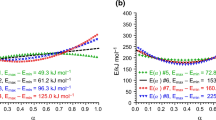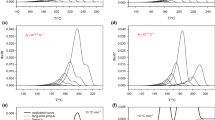Abstract
Novel methods of unified evaluation of two (or more) thermogravimetric curves have been worked out on the basis of known non-linear parameter estimating procedures (Gauss-Newton-Marquardt-type regression and the direct integral method of Valkó and Vajda were adapted). Their ability to provide estimate for common kinetic parameters of several TG (m−T) or DTG (dm/dt-T) curves were tested for pairs of curves of different heating rates, and for repeated curves of the same heating rate, obtained for the decomposition of CaCO3 in open crucible. In these cases the Arrhenius terms and then-th order model functions were assumed. The fitting ability of estimations made for single curves and for pairs of curves sharing different number of parameters, was judged on the base of residual deviations (S res ) and compared to the standard deviation of the measurements.
In the case of different heating rates, the two curves could not be described with the assumption of three common parameters, because of the minimum residual deviation was very high. However, sharing of activation energy and preexponential term only, and applying different exponents for the two curves, provided a satisfactory fit by our methods. Whilst in the case of repeated curves, we could find such a common three-parameter set, which has a residual deviation comparable with the standard deviation of the measurements.
Because of their flexibility (taking into account the variable number of common parameters and the versatile forms of model equations), these methods seem to be promising means for unified evaluation of several related thermoanalytical curves.
Zusammenfassung
Auf der Basis bekannter nichtlinearer Parameter-Schätzungsverfahren (Adaption der Gauss-Newton-Marquardt-Regression und der direkten Integrationsmethode von Valkó und Vajda) wurden neue Methoden zur gemeinsamen Auswertung von zwei (oder mehr) thermogravimetrischen Kurven ausgearbeitet. Ihre Fähigkeit zur Schätzungen von gewöhnlichen kinetischen Parametern einiger TG (m-T)-oder DTG (dm/dt-T)-Kurven wurde für Kurvenpaare unterschiedlicher Aufheizgeschwindigkeit und für wiederholte Kurven bei gleicher Aufheizgeschwindigkeit an der Zersetzung von CaCO3 in einem offenen Ofen getestet. In diesen Fällen wurden Arrhenius'sche Ausdrücke und Modellfunktionenn-ter Ordnung vorausgesetzt. Die Fitting-Fähigkeit der Schätzungen für Einfachkurven und für Kurvenpaare mit einer unterschiedlichen Anzahl von Parametern wurde auf der Basis der residualen Deviationen (S res) überprüft und mit der Standarddeviation der Messungen verglichen.
Im Falle unterschiedlicher Aufheizgeschwindigkeiten konnten die zwei Kurven unter Annahme von drei gewöhnlichen Parametern nicht beschrieben werden, da die minimale residuale Deviation sehr hoch war. Die Anwendung von nur Aktivierungsenergie und präexponentiellem Faktor sowie von verschiedenen Exponenten für die beiden Kurven lieferte ein zufriedenstellendes Fitting unserer Methode. Dagegen konnten wir im Falle der wiederholten Kurven ein solches Tripel üblicher Parameter finden, welches eine vergleichbare residuale Deviation wie die Standarddeviation der Messungen aufweist.
Aufgrund ihrer Flexibílität (unter Berücksichtigung der unterschiedlichen Anzahl gewöhnlicher Parameter und der flexiblen Form der Modellgleichungen) scheinen diese Methoden vielversprechende Mittel zur gemeinsamen Auswertung einiger verwandter thermoanalytischer Kurven zu sein.
Similar content being viewed by others
References
H. E. Kissinger, Anal. Chem., 29 (1957) 1702.
T. Ozawa, Bull. Chem. Soc. Japan., 38 (1965) 1881.
J. H. Flynn and L. A. Wall, Polym. Lett., 4 (1966) 323.
H. L. Friedman, J. Polym. Sci., 6 (1965) 183.
G. Pokol and G. Várhegyi, Crit. Rev. Anal. Chem., 19 (1988) 65.
M. E. Brown, Introduction to Thermal Analysis, Chapman and Hall, London, New York 1988, Chap. 13.
F. F. Martin, Computer Modelling and Simulation, Wiley, New York 1968.
P. Valkó and S. Vajda, Advanced Scientific Computing in Basic, With Applications in Chemistry, Biology and Pharmacology, Elsevier, New York 1989.
G. Várhegyi, Thermochim. Acta, 28 (1979) 367.
G. Várhegyi, Thermochim. Acta, 28 (1979) 625.
J. Zsakó, J. Thermal Anal., 9 (1976) 101.
J. Sesták, Proc. 6th International Conference on Thermal Analysis, Vol. 1., Wiedemann, H. G., Ed., Birkhaeuser, Basel 1980, p. 29.
Z. Adonyi and G. Körösi, Thermochim. Acta, 60 (1983) 23.
N. Koga and H. Tanaka, J. Thermal Anal., 37 (1991) 347.
M. Arnold, G. E. Veress, J. Paulik and F. Paulik, Anal. Chim. Acta, 124 (1981) 341.
G. Pokol, S. Gál and E. Pungor, Anal. Chim. Acta, 175 (1985) 289.
Author information
Authors and Affiliations
Rights and permissions
About this article
Cite this article
Madarász, J., Pokol, G. & Gál, S. Application of non-linear regression methods for the estimation of common kinetic parameters from several thermoanalytical curves. Journal of Thermal Analysis 42, 539–550 (1994). https://doi.org/10.1007/BF02548534
Issue Date:
DOI: https://doi.org/10.1007/BF02548534




